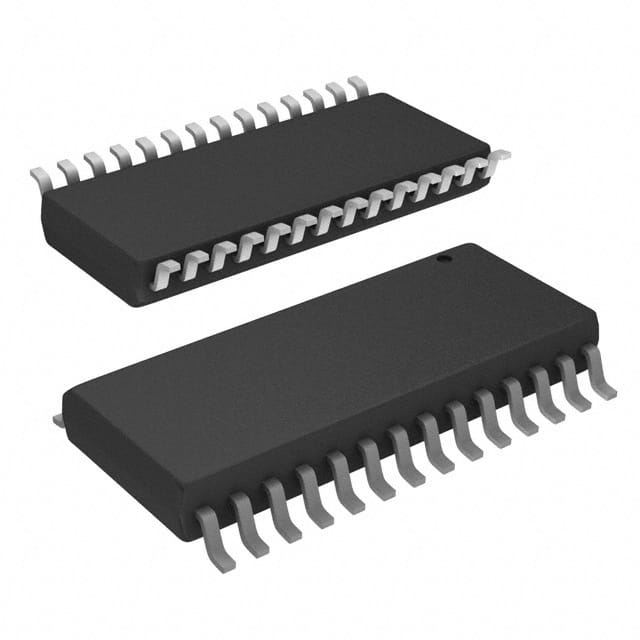Lihat spesifikasi untuk detail produk.

AT28C64E-15SI
Product Overview
Category
AT28C64E-15SI belongs to the category of electrically erasable programmable read-only memory (EEPROM) chips.
Use
This product is primarily used for non-volatile data storage in various electronic devices such as microcontrollers, computers, and consumer electronics.
Characteristics
- Electrically erasable: The AT28C64E-15SI can be erased and reprogrammed electronically, making it convenient for updating stored data.
- Non-volatile: The stored data remains intact even when power is removed.
- High capacity: This chip has a storage capacity of 64 kilobits (8 kilobytes), allowing for ample data storage.
- Fast operation: With a speed rating of 150 nanoseconds, it offers quick access to stored information.
Package
The AT28C64E-15SI comes in a standard 28-pin Small-Outline Integrated Circuit (SOIC) package. This package provides a compact and reliable form factor for easy integration into electronic systems.
Essence
The essence of the AT28C64E-15SI lies in its ability to store and retrieve data reliably, while offering the flexibility of electronic erasure and reprogramming.
Packaging/Quantity
This product is typically packaged in reels or tubes, with each reel or tube containing a specific quantity of AT28C64E-15SI chips. The exact quantity may vary depending on the manufacturer's specifications.
Specifications
- Storage Capacity: 64 kilobits (8 kilobytes)
- Operating Voltage: 2.7V to 5.5V
- Speed Rating: 150 nanoseconds
- Interface: Parallel
- Erase/Write Endurance: 10,000 cycles
- Data Retention: 10 years
Detailed Pin Configuration
The AT28C64E-15SI has a total of 28 pins, each serving a specific function. The pin configuration is as follows:
- A0 - Address Input
- A1 - Address Input
- A2 - Address Input
- A3 - Address Input
- A4 - Address Input
- A5 - Address Input
- A6 - Address Input
- A7 - Address Input
- VSS - Ground
- A8 - Address Input
- A9 - Address Input
- A10 - Address Input
- OE - Output Enable
- CE - Chip Enable
- WE - Write Enable
- I/O0 - Data Input/Output
- I/O1 - Data Input/Output
- I/O2 - Data Input/Output
- I/O3 - Data Input/Output
- I/O4 - Data Input/Output
- I/O5 - Data Input/Output
- I/O6 - Data Input/Output
- I/O7 - Data Input/Output
- NC - No Connection
- VCC - Power Supply
- NC - No Connection
- NC - No Connection
- NC - No Connection
Functional Features
- Easy data storage: The AT28C64E-15SI allows users to easily store and retrieve data electronically.
- High-speed operation: With a speed rating of 150 nanoseconds, it offers fast access to stored information.
- Reliable performance: This chip ensures data integrity and retention even in harsh operating conditions.
- Low power consumption: The AT28C64E-15SI is designed to minimize power consumption, making it suitable for battery-powered devices.
Advantages and Disadvantages
Advantages
- Electrically erasable and reprogrammable
- Non-volatile data storage
- High storage capacity
- Fast operation
Disadvantages
- Limited erase/write endurance (10,000 cycles)
- Relatively higher cost compared to other memory technologies
Working Principles
The AT28C64E-15SI utilizes a combination of electronic circuits and memory cells to store and retrieve data. When the chip is powered on and enabled, the address inputs are used to select a specific memory location. The data stored in that location can be read by enabling the output enable pin. To write new data, the chip must be enabled and the write enable pin activated. The data input pins are then used to provide the desired information for storage.
Detailed Application Field Plans
The AT28C64E-15SI finds applications in various fields where non-volatile data storage is required. Some potential application areas include:
- Microcontrollers: Used for storing firmware, configuration settings, and calibration data.
- Computers: Employed in BIOS chips for storing system startup instructions and settings.
- Consumer Electronics: Utilized in devices such as digital cameras, smart TVs
Sebutkan 10 pertanyaan dan jawaban umum terkait penerapan AT28C64E-15SI dalam solusi teknis
Sure! Here are 10 common questions and answers related to the application of AT28C64E-15SI in technical solutions:
Q: What is the AT28C64E-15SI? A: The AT28C64E-15SI is a 64K (8K x 8) Electrically Erasable Programmable Read-Only Memory (EEPROM) chip.
Q: What is the operating voltage range for the AT28C64E-15SI? A: The AT28C64E-15SI operates within a voltage range of 4.5V to 5.5V.
Q: What is the maximum clock frequency supported by the AT28C64E-15SI? A: The AT28C64E-15SI supports a maximum clock frequency of 150 ns.
Q: Can the AT28C64E-15SI be used as a storage device in microcontroller-based systems? A: Yes, the AT28C64E-15SI can be used as a non-volatile storage device in microcontroller-based systems.
Q: How many write cycles can the AT28C64E-15SI endure? A: The AT28C64E-15SI can endure a minimum of 10,000 write cycles.
Q: Does the AT28C64E-15SI support byte-level read and write operations? A: Yes, the AT28C64E-15SI supports byte-level read and write operations.
Q: Can the AT28C64E-15SI retain data without power supply? A: Yes, the AT28C64E-15SI is non-volatile, meaning it can retain data even without power supply.
Q: What is the package type of the AT28C64E-15SI? A: The AT28C64E-15SI comes in a 28-pin Small-Outline Integrated Circuit (SOIC) package.
Q: Is the AT28C64E-15SI compatible with standard EEPROM programming algorithms? A: Yes, the AT28C64E-15SI is compatible with standard EEPROM programming algorithms.
Q: Can the AT28C64E-15SI be used in automotive applications? A: Yes, the AT28C64E-15SI is suitable for use in automotive applications as it meets the necessary requirements and standards.
Please note that these answers are general and may vary depending on specific application requirements and datasheet specifications.

